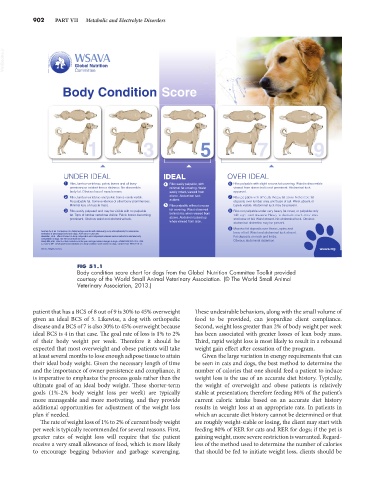Page 930 - Small Animal Internal Medicine, 6th Edition
P. 930
902 PART VII Metabolic and Electrolyte Disorders
VetBooks.ir
Body Condition Score
1 3 5 7 9
UNDER IDEAL IDEAL OVER IDEAL
1 Ribs, lumbar vertebrae, pelvic bones and all bony 4 Ribs easily palpable, with 6 Ribs palpable with slight excess fat covering. Waist is discernible
prominences evident from a distance. No discernible minimal fat covering. Waist viewed from above but is not prominent. Abdominal tuck
body fat. Obvious loss of muscle mass. easily noted, viewed from apparent.
2 Ribs, lumbar vertebrae and pelvic bones easily visible. above. Abdominal tuck 7 Ribs
No palpable fat. Some evidence of other bony prominences. evident. deposits over lumbar area and base of tail. Waist absent or
Minimal loss of muscle mass. 5 Ribs palpable without excess barely visible. Abdominal tuck may be present.
3 Ribs easily palpated and may be visible with no palpable fat covering. Waist observed 8 Ribs not palpable under very heavy fat cover, or palpable only
fat. Tops of lumbar vertebrae visible. Pelvic bones becoming behind ribs when viewed from
prominent. Obvious waist and abdominal tuck. above. Abdomen tucked up and base of tail. Waist absent. No abdominal tuck. Obvious
when viewed from side. abdominal distention may be present.
9 Massive fat deposits over thorax, spine and
German A, et al. Comparison of a bioimpedance monitor with dual-energy x-ray absorptiometry for noninvasive base of tail. Waist and abdominal tuck absent.
estimation of percentage body fat in dogs. AJVR 2010;71:393-398.
Jeusette I, et al. Effect of breed on body composition and comparison between various methods to estimate body Fat deposits on neck and limbs.
composition in dogs. Res Vet Sci 2010;88:227-232. Obvious abdominal distention.
Kealy RD, et al. Effects of diet restriction on life span and age-related changes in dogs. JAVMA 2002;220:1315-1320.
Development and validation of a body condition score system for dogs. Canine Pract 1997;22:10-15.
©2013. All rights reserved. wsava.org
FIG 51.1
Body condition score chart for dogs from the Global Nutrition Committee Toolkit provided
courtesy of the World Small Animal Veterinary Association. (© The World Small Animal
Veterinary Association, 2013.)
patient that has a BCS of 8 out of 9 is 30% to 45% overweight These undesirable behaviors, along with the small volume of
given an ideal BCS of 5. Likewise, a dog with orthopedic food to be provided, can jeopardize client compliance.
disease and a BCS of 7 is also 30% to 45% overweight because Second, weight loss greater than 2% of body weight per week
ideal BCS is 4 in that case. The goal rate of loss is 1% to 2% has been associated with greater losses of lean body mass.
of their body weight per week. Therefore it should be Third, rapid weight loss is most likely to result in a rebound
expected that most overweight and obese patients will take weight gain effect after cessation of the program.
at least several months to lose enough adipose tissue to attain Given the large variation in energy requirements that can
their ideal body weight. Given the necessary length of time be seen in cats and dogs, the best method to determine the
and the importance of owner persistence and compliance, it number of calories that one should feed a patient to induce
is imperative to emphasize the process goals rather than the weight loss is the use of an accurate diet history. Typically,
ultimate goal of an ideal body weight. These shorter-term the weight of overweight and obese patients is relatively
goals (1%-2% body weight loss per week) are typically stable at presentation; therefore feeding 80% of the patient’s
more manageable and more motivating, and they provide current caloric intake based on an accurate diet history
additional opportunities for adjustment of the weight loss results in weight loss at an appropriate rate. In patients in
plan if needed. which an accurate diet history cannot be determined or that
The rate of weight loss of 1% to 2% of current body weight are roughly weight-stable or losing, the client may start with
per week is typically recommended for several reasons. First, feeding 80% of RER for cats and RER for dogs; if the pet is
greater rates of weight loss will require that the patient gaining weight, more severe restriction is warranted. Regard-
receive a very small allowance of food, which is more likely less of the method used to determine the number of calories
to encourage begging behavior and garbage scavenging. that should be fed to initiate weight loss, clients should be

